Looking to simplify your closet and create a more streamlined, minimalist wardrobe? You’re not alone. In recent years, the minimalist lifestyle has gained increasing popularity, and many people are realising the benefits of having fewer clothes that they actually love and wear.
I should know. As a reformed shopaholic who once transformed my entire guest bedroom into a walk-in closet, I’ve seen firsthand how a minimalist wardrobe can reduce decision fatigue, save time and money, and create a sense of calm and clarity in your daily life. For me, it has been nothing short of life-changing!
But where to start?
I know simplifying can feel overwhelming, especially if you’re used to having a lot of options—but I’ve got your back. In this blog post, you’ll learn practical tips and tricks to help you create a minimalist wardrobe that works for you.
From decluttering your closet to choosing versatile pieces that can be mixed and matched, this is everything you need to know to create a stylish and sustainable wardrobe that reflects your personal style.
So let’s get started on your journey towards a simpler, more intentional closet!
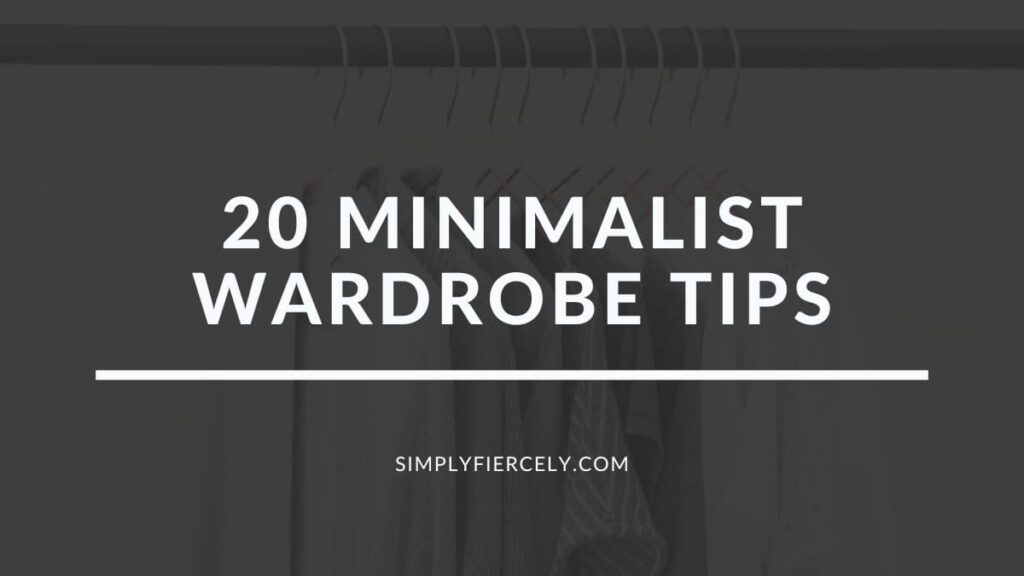
Tour My Minimalist Wardrobe
Before I share my minimalist wardrobe tips, I thought you might like a sneak peek inside my closet!
This video is a bit out of date—I filmed this in 2019, and since then I’ve downsized ever further (especially after doing a no new clothes challenge where I didn’t shop for 13 months!). Still, I think it’s worth checking out, especially if you have a hard time imagining what a “realistic” minimal wardrobe might look like.
20 Minimalist Wardrobe Tips
1. Get comfortable with repeating outfits
I used to think that in order to be stylish, I had to follow the latest trends and put together new outfits all the time. I wore a lot of fast fashion, poorly made pieces that were in one season and out the next; clothing items that didn’t really suit me, but I didn’t care as long as I could show off a variety of looks.
But you know what? When I look back on that period of my life, I never felt very confident, and I’m sure it showed.
Fortunately, I eventually discovered the magic of dressing with a personal uniform. And no, this doesn’t mean I wear the exact same thing every day! Of course, you can, if you want, but I prefer defining a few go-to styles that I love (I call them outfit formulas).
These outfits are tried and tested, so even though I wear them on repeat, I feel great because I’m always wearing my favourite outfits. I spend less time getting dressed, and I feel more fashionable than ever.
2. Pay attention to fabrics
When I first decluttered my closet, one of the best things I did was to pay attention to fabrics.
Why? Because you can have the most beautiful clothes, but if they don’t feel good on your skin, you’re always going to reach for something else.
It’s a pattern I noticed in my own closet. Even though I loved the look of my more “fashion” pieces, my favourite clothes to wear were things like cotton t-shirts and linen dresses. I live in a hot climate, and these fabrics are so much more comfortable than synthetics like polyester.
When I realised this, it was a lightbulb moment. My fabric choices explained why I didn’t wear so many of the things I thought I loved. Now I’m able to make better choices, and I’ve curated a collection of clothes I actually love to wear.
3. Define boundaries and create your own fashion rules
It’s so easy to get caught up in what the magazines say we should or shouldn’t wear. (Who remembers those Do’s and Don’ts lists that use to be so popular!) It would be great if only there was some consistency.
Instead, styles change every season, leaving many of us with overflowing closets and a hodgepodge of random clothes.
You know the saying: a closet full of clothes with nothing to wear…
But here’s a tip that will help you take a minimalist approach to your closet. Think long and hard about what you will (or won’t) wear, and be specific.
For example, I never wear wide-legged trousers (I love the style but it doesn’t suit me), the colour yellow (again—I like it on other people but not me), and I don’t buy things dry clean only (I am way to lazy to go to the dry cleaners!).
This knowledge is powerful because it’s the first step to simplifying. In a sense, you’re making your own personal Do’s and Don’ts list that you can use as a guide when you’re decluttering your closet AND when you’re shopping (so you stop buying clothes you never wear). It’s a simple concept, but it’s so helpful when creating your own minimalist style.
4. Borrow instead of buying
A simple minimalist wardrobe tip is to borrow clothes that you know you only need for a short period of time. For example, if you need a dress for special occasions or a warm jacket for a ski trip.
Or if you’re not comfortable asking, consider renting! There are businesses where you can rent high-quality pieces for considerably less than buying them, and it’s sustainable (for the earth and your closet) because you return your items after wearing them. Admittedly, this is a new industry, but new businesses are popping up every day.
5. Understand you can admire a style without wanting to wear it.
I use to spend so much money on things I loved but never wore, and I could never figure out why … until I realised that there’s a difference between admiring a style on someone else and wanting to wear it myself.
For example, I love vintage/retro fashion (especially anything from the ’40s or ’50s), and I used to have a big collection. I’d spend a lot of time admiring these beautiful pieces, but I wouldn’t wear them. Now I can see that I enjoyed them in the same way you enjoy art in a museum. I appreciate a lot of art, but it doesn’t mean I want it all hanging in my living room! It’s a simple idea, but it was a game-changer for me!
6. Avoid clothes that require specialty undergarments
… unless you already own them and are 100% comfortable wearing them.
For example, don’t buy a dress knowing you need to go out and buy a speciality bra before you can wear it. That’s a great way to flush money down the drain.
7. Be honest about how much you’re willing to suffer for fashion
Speaking of speciality undergarments, I think most people overestimate how much they’re willing to suffer for fashion.
We buy pairs of jeans that don’t quite fit just because they’re on sale or squeeze ourselves into cheap heels that kill our feet and then never get worn again.
Trust me, I get it. It’s so easy to talk yourself into things when you’re shopping, and you fall in love with beautiful pieces of clothing. But be honest with yourself. If you always find yourself reaching for sandals and tank tops, you’re not going to get a lot of wear out of that pencil skirt. Once I got honest with myself about the importance of comfort in my wardrobe, I stopped buying (and holding onto) anything that didn’t meet those criteria.
The Simply + Fiercely Show is a podcast for women who want to clear their clutter and create space for freedom and joy. If your life keeps getting bigger—but not better—then it’s time to declutter from the inside out. LISTEN NOW
8. Know that you’re not defined by what you wear
I know that most people “know” on an intellectual level, but often our choices tell a different story.
This is why we hang onto clothes that no longer fit or struggle to say goodbye to items that remind us of our youth. We’re still attached to who we used to be in those clothes (or perhaps more accurately, who we thought we were), so letting go feels hard.
If you struggle with this, I recommend investing time into increasing your self-worth. The more confident you feel about yourself, the less you’ll need your clothes to define you.
9. Get to know a good tailor
Here’s a reality check for you: if you buy ready-to-wear fashion (99% of what’s on the market), then you probably struggle with fit issues. This isn’t about your size—it’s about body shape. No one pattern will ever fit everybody because everyone’s body is different.
This is where a tailor can help. If you struggle to find essential items of clothing that work for you— classic pieces like a pair of jeans or button-down shirts —don’t go searching for new pieces. Instead, chat with a tailor. He or she might be able to customise something you already own, leaving you with a high-quality piece that’s made for you.
Pro Tip: Before you shop, it’s important to know what a tailor can and can’t do.
10. Do a wardrobe audit
I believe that clutter in all forms stems from a lack of clarity, and this is especially true in your wardrobe. With so many people, what they think they like wearing and what they actually wear are two completely different things. This is how we end up with too much clothing and nothing to wear.
So how to fix this? I think the best way is to start with a wardrobe audit.
Take a long hard look at what you wear and why, and conversely, what you don’t wear and why. It’s like being a detective: what do your favourite clothes tell you about your personal style? I know this sounds simple, but trust me—when you start paying attention, you’ll be surprised by what you learn.
Want to learn more about how to do a wardrobe audit? Then be sure to check out my closet decluttering program, the One Day Closet Cleanse.
I’ve helped hundreds of women clear their closets without the stress and overwhelm using a unique approach that reduces decision fatigue and helps you create your own capsule collection. Say “goodbye” to things you never wear and “hello” to a functional closet full of items you can’t wait to put on.
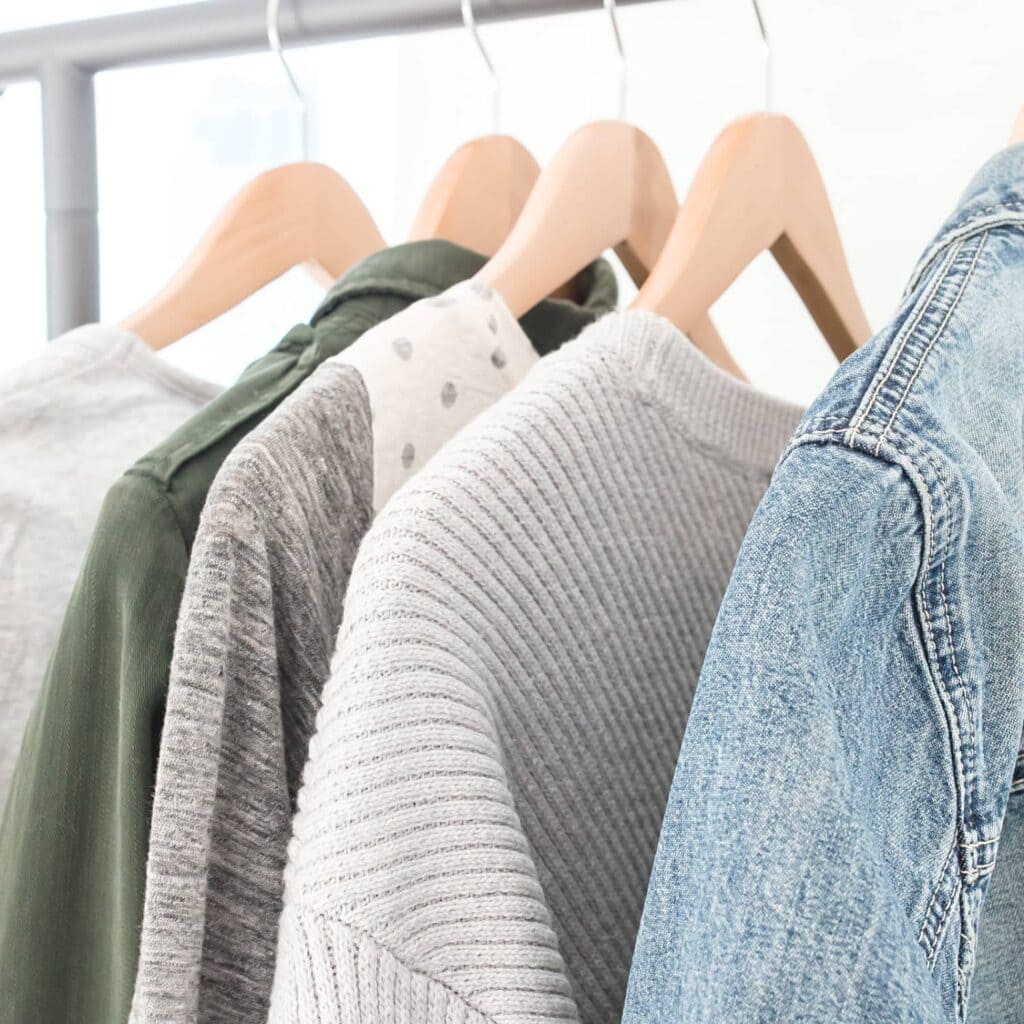
11. Shop with a list and always do research
Let’s be real—clothing shops are designed to manipulate you. Everything from the displays to the music (and sometimes even the smells!) are carefully designed to encourage you to buy. Millions and millions of dollars are spent on consumer research because retailers want us to make impulsive decisions.
But there’s a simple yet surprisingly easy way to combat this: always shop with a list and do your research first.
Know what you need and be specific. If you want black pants, then what style? What fit? And what fabric? I like to read reviews too—you’d be surprised what information you can find online. Narrow it down to a few specific options (or at least have clear criteria) before you get to the shops, and you’ll be less likely to be influenced by marketing gimmicks.
12. Let go of perfect
Before I started dressing with a more minimalist wardrobe, I spent a lot of time searching for the perfect little black dress… and the perfect white t-shirt … and the perfect classic trench coat … and the —well, I think you get the idea.
I believe in quality over quantity, trust me. But I also think it’s a slippery slope into perfectionism.
Because here’s the thing: perfect isn’t real. You can buy the most amazing leather jacket of your dreams, and then next week you’ll see some celebrity with one you like better and suddenly yours won’t be good enough anymore. That’s just how it works when you’re seeking perfection. I can guarantee that there will always be something better.
When you accept this (in your wardrobe and in every part of your life) it gives you permission to say, “good enough is good enough”. I’m not saying you have to settle for poor quality but think about your time, money and energy. Remember, there are more important things in life than having the perfect wardrobe (minimalist or otherwise) and accepting this will set you free.
13: Hemlines, necklines and more: know what you like!
Most people favour certain hemlines, necklines, waistlines, etc. Getting clear on your preferences is essential to creating a functional minimalist wardrobe.
14. Experiment with going without
Most of us have nearly 24/7 access to shops and as a result, we’ve become accustomed to having our needs immediately satisfied. For example, if I’m trying on a dress and I don’t love how it looks with the shoes currently in my closet, I can hop online and buy a new pair in minutes (and have it delivered the next day!)
Sometimes this convenience is a gift, but let’s face it—we’ve all picked up bad habits.
Instead of saving up for high-quality, well-made garments, we impulsively buy whatever’s on sale; instead of waiting for next season to update our wardrobe, we browse new styles once a week; and instead of making do with what we have, we overflow our closets with items that will eventually overflow donation centres.
I say this with compassion because I’ve been there, and I understand the temptation. But if you want to buy less but better, the first step is to slow down and press pause now and again.
Related Post: How to Be Happy With What You Have + Stop Wanting More
15. Take good care of your favourite clothes
One of the challenges of having a minimalist wardrobe with a small selection of clothes is you need to take better care of them. Here are a few tips that have worked for me:
- Wash your clothes less often – I know this depends a lot on your lifestyle (this was so much easier before kids!), but every little bit helps. Try airing out your clothes and getting more wear between washes.
- Avoid the dryer – When I moved to Australia from the US, I was surprised to learn most people here don’t use a dryer. At first, it was an inconvenience but now I know it’s a gift. Air drying is so much gentler on your clothes and your electricity bill!
- Read (and follow) the care instructions – I know, don’t shout at me! This should be a no-brainer but I’ll be the first to admit that I was careless when I was younger. Now I always check the washing instructions and if I’m not willing to follow them, I don’t buy the item in the first place!
16. Organise your closet
Personally, I find that having an aesthetically pleasing closet helps me to maintain a minimalist wardrobe. I don’t want to clutter it with excess clothing because I enjoy looking at such a beautiful and functional space!
Of course, this isn’t a “must do” but you might want to try:
- using matching hangers
- arranging your clothes by colour,
- using storage bins that match your decor for smaller items
But remember, always declutter clothes before you organise!
PRO TIP: Take a picture of your closet once you’ve organised it and keep it somewhere handy. Look at it before you buy anything and ask yourself: Do I physically have space for a new purchase? Do I already own something that will do the same job? Does this new item fit my existing style? (This is especially helpful with identifying your colour scheme!)
17. Choose versatile items
You don’t have to be boring. Minimalist fashion doesn’t necessarily mean neutral colours and you can still express your unique style. However, you will get a lot more value out of your closet if you own some pieces that can be used for a variety of different looks.
Here are some examples:
- A denim shirt looks great on its own or you can wear it as a jacket
- A simple t-shirt dress can be worn in the summer with sandals or you could add tights, boots and a cardigan in the winter
- High-quality tanks or camisoles can be worn alone or under sweaters, jackets, etc.
Be wary of pieces that are hard to layer (billowy sleeves or strange necklines) or items with very limited use. You can still indulge if that reflects your personal style, but if you do it in moderation, you’ll get a higher number of outfits from fewer clothes.
18. Stop comparing yourself to other people
This tip might seem out of place, but I can almost guarantee that the more time you spend looking at other people’s wardrobes, the less content you’ll feel with your own.
If you want to know how to stop comparing yourself to others, three things I did were: stop buying fashion magazines, stop reading fashion blogs, and be really mindful of who I follow on social media.
19. Experiment with a capsule wardrobe
If you’re sold on the idea of a minimalist wardrobe and you want to get the greatest impact with the least effort, I recommend considering a capsule wardrobe.
A minimalist capsule wardrobe is a curated selection of clothes where (almost) everything mixes and matches. There’s no magic number of items it should include, so don’t stress about getting it perfect. Instead, focus on versatility.
While I’m not strict about it (I don’t have too many clothes, to begin with), I do follow the general concept of a capsule wardrobe. Almost all of my tops go with almost all of my bottoms, and it makes early mornings a breeze. I could pretty much reach into my closet with my eyes closed, and be guaranteed that I’ll put out a decent outfit to wear!
20. Stop taking it all so seriously
Finally, a bit of tough love from someone who REALLY needed to hear this fifteen years ago.
At the end of the day, no one cares what you’re wearing. Dress for yourself, of course, but be mindful of how much time, energy and money you’re investing into your wardrobe. Does this reflect your values and priorities? Or have things gone a bit askew?
I’ve been there and that’s why I’m passionate about simplifying. There are so many benefits of a capsule wardrobe or simply reducing your options. Spend less time worrying about what to wear, and you’ll find you have less stress and more energy for the things that matter.
Learn More About Creating a Minimalist Closet
If you enjoyed this blog post, be sure to check out:
- What To Do When You Have Too Many Clothes
- Inspiration and Ideas for a Minimalist Spring Capsule Wardrobe
- Minimalist Winter Outfits + How to Make The Most of Your Closet
- A Simple Guide to A Simple Wardrobe
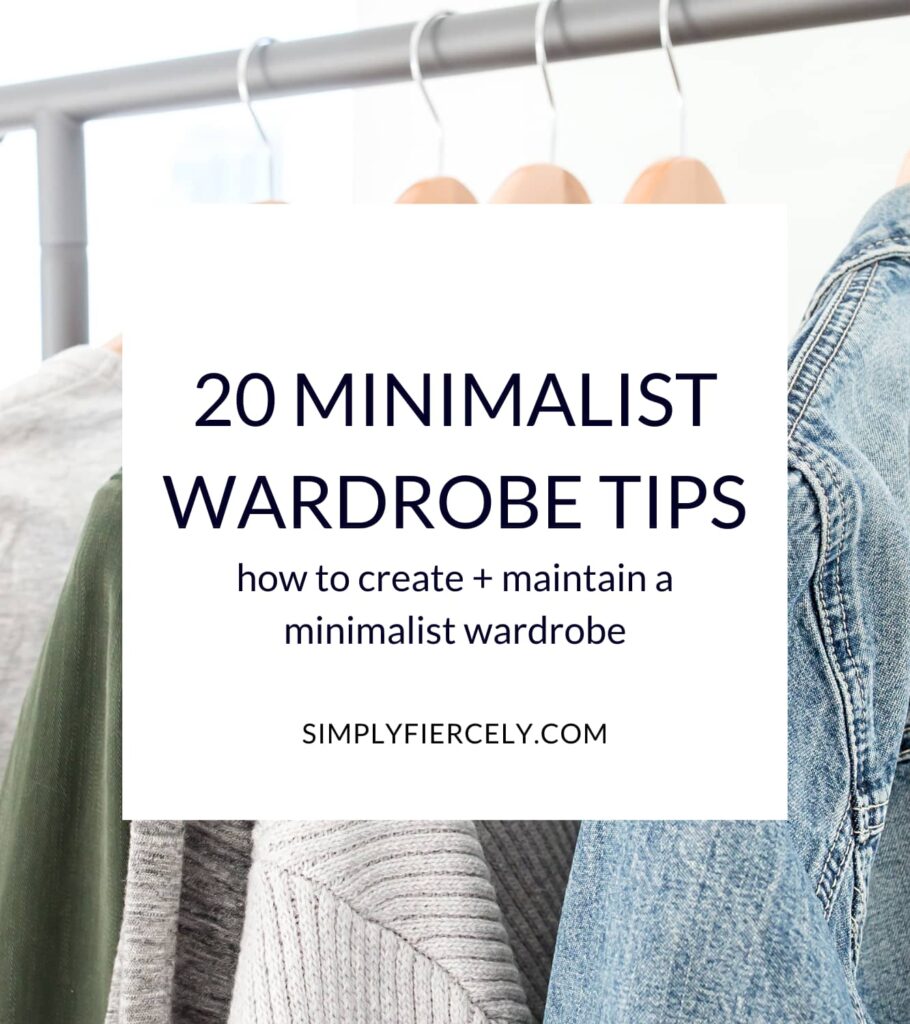

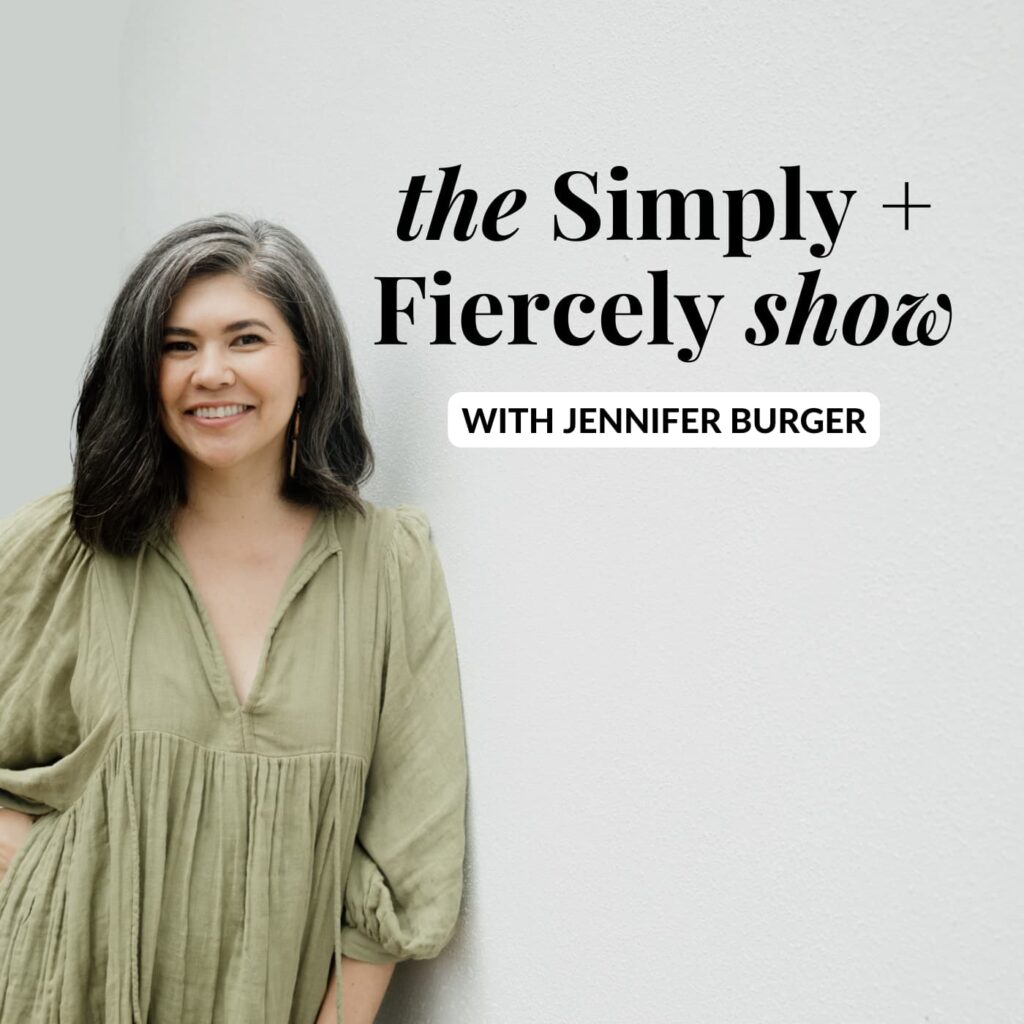
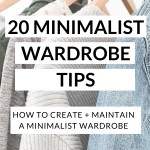
역대최저가격강남셔츠룸강남셔츠룸가격정보
역대최저가격강남가라오케강남가라오케가격정보
역대최저가격강남하이퍼블릭강남하이퍼블릭가격정보
역대최저가격강남가라오케강남가라오케가격정보
역대최저가격강남세미텐카페강남세미텐카페가격정보
역대최저가격강남세미카페강남세미카페가격정보
역대최저가격강남룸싸롱강남룸싸롱가격정보
역대최저가격강남가라오케강남가라오케가격정보
역대최저가격강남셔츠룸강남셔츠룸가격정보
역대최저가격선릉가라오케선릉셔츠룸가격정보
역대최저가격사라있네가라오케사라있네가격정보
역대최저가격강남셔츠룸강남셔츠룸가격정보
역대최저가격강남가라오케퍼펙트가라오케
역대최저가격강남가라오케강남가라오케가격정보
Hi Jennifer,
So many great tips and steps on how to implement a minimalist wardrobe!
I like your point about admiring a style without having to wear it. Sometimes, I see a beautiful piece of clothing in the mall, but deep down inside, I know it’s either 1. the wrong color for my skin tone or 2. the wrong fit for my body type.
Is there anything wrong with buying a special piece that isn’t really suited for your skin tone or body? Not at all! However, for me, if I buy a piece of clothing or shoes that really don’t suit me, I end up just leaving it in my closet, collecting dust. Acquiring stuff only to let it sit in our closets isn’t minimalist living at all!
Another way to create a minimalist wardrobe is to focus on one season and choose several key pieces for that season. Depending on where you live, you may need only 1 or 2 wardrobes (like in a tropical climate) or 4 if you live in a colder part of North America (spring, summer, autumn, winter).
If someone is just starting out with a minimalist wardrobe, what are the top 3 pieces of clothing you think they should buy and why?
– Jani, Frugal Fun Finance
black trousers
black skirt
white cardigan with black trim
if you have loads of clothes you have not been wearing – put them all on hangers [i prefer the cheap plastic ones – all matching – bright red] and every morning wear something different. if after a few wearings you dont like it – then it can go.
but no point holding on to things and not wearing them. this way you will get some wear from things you have spent good money on – unworn clothes, shoes and bags is just money down the drain. sometimes things you didnt like – look better the following year.
Really great arcticle!
It quite made me think deep about clothes in my closet. Like why do I own FOUR dresses and i literally wore a dress like twice in my life. Or why do i have so much t-shirts and wear half of it… It makes me feel somehow ridiculous cause I’ve been a minimalist for maybe over three years. I donated a lot of clothes but i kept buying new stuff and thinking like “i need this” when i don’t need it at all.
So i really wanna thank you for this arcticle, it was kinda an eye opener to stand with my beliefs in life and not being dragged on with a trend.
Helpful for me, after getting to a comfortable minimalist closet, was making sure that if something new came in, something else had to go. One in, one out.🌻
Totally brilliant post…so useful I love it!
I love most of your idea’s!! I have a real problem with the borrowing that keeps coming up in minimalists blogs I read!! Don’t come to borrow personal items from me!! My clothes, books, perfume etc. I will loan you a rake or shovel…once, not repeatedly. If you need one…go buy one!!! This is shifty thinking to borrow like this!! Now, if we’re talking a single mom who needs a dress for her daughters prom and simple doesn’t have the money I would help her find a dress and do her hair and make-up and let her wear one of my perfumes!! Of course!! BUT, if it we’re the mom wanting to go out on a date…she needs to fund her fun time!! It’s called being responsible for yourself!!
Hi Natalie! Of course, everyone has to decide what they are comfortable with 🙂 But for me, when I think of borrowing, it usually applies to “one off” things that you won’t use often and it doesn’t make sense to own. For example, I live in a subtropical climate and don’t own a winter coat! But if I was going on a ski holiday, I would probably try to borrow from a friend rather than buy one that would never get worn again. I wouldn’t borrow a dress every Friday night (but for some people that might work well — depending on their social network!). It’s all about finding what you’re comfortable with, and I think it’s great you have strong boundaries. Thanks for reading!
Jennifer, I still have a problem with someone borrowing a item just for a one time event. If it’s a seldom worn item for me I’m not loaning it to people who don’t think the need to buy their own!! Why shouldn’t you spend our own money?! Now, I understand if it’s your sister or mom!! Even as close friends I don’t loan out my things!! They need to spend their own money just like I did!!!
Fair enough! But there are now clothing rental services where people can “borrow” outfits for a fee. A good option for fancy occasions?
Everyone has different interests and activities and lifestyles–and thus will potentially own different things. I still have a HUGE closet of renaissance festival clothing as I worked at one for over a decade. It totally makes sense for a friend who rarely attends (or is going to a one time event needing a costume) to borrow from me. Similarly I’ve a friend who’s big into baking who’s happy to loan out speciality cake pans to folks. That give and take not only reduces waste and saves folks money and time but also help build strong, interconnected communities.
Thank you for your video. That’s a forward slash, not a back slash 🙂
I love your site and this article. Great tips!
Great article! Good advice as well as reminders!.
Where did you get your tanks? I love them! Especially the one you’re wearing in the video.
Do you not have any cardigans? If so, what colors? Thank you I live in tropical climate as well